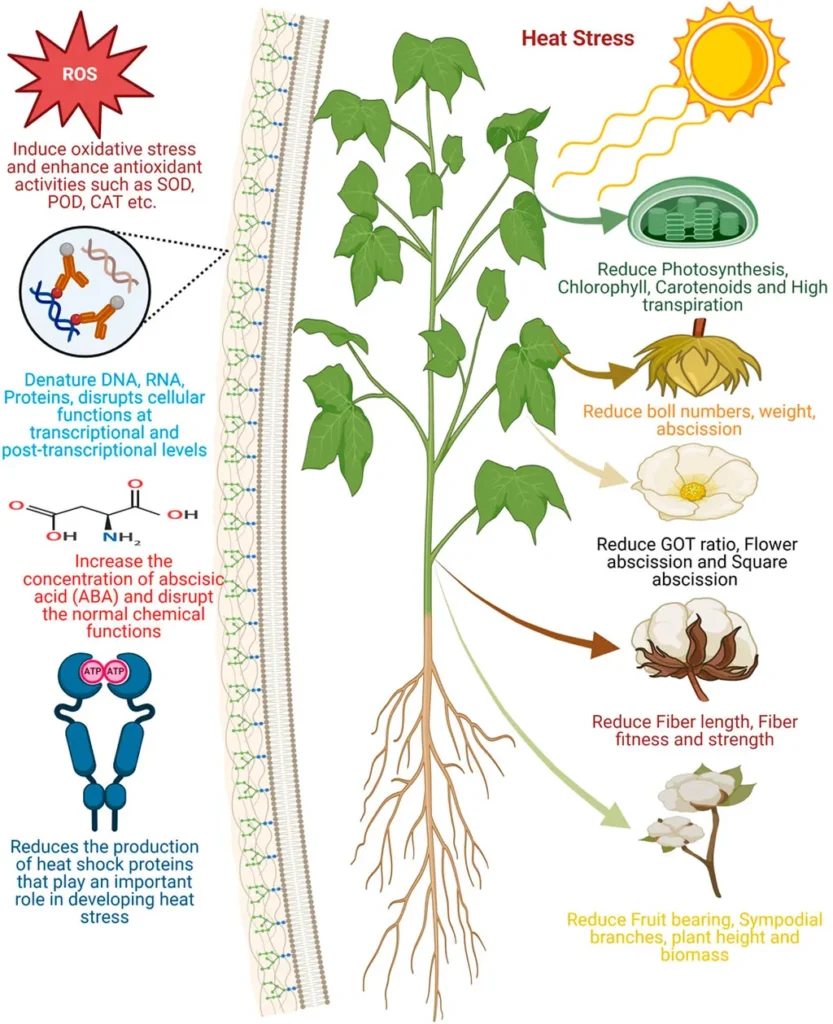In the heart of China, researchers at the National Key Laboratory of Crop Genetic Improvement & Hubei Hongshan Laboratory, Huazhong Agricultural University, have uncovered a fascinating interplay between circadian rhythms, high temperature stress, and jasmonic acid signaling in cotton and Arabidopsis. This research, led by Aamir Hamid Khan, could have significant implications for the agricultural sector, particularly in the face of climate change and the increasing frequency of heatwaves.
The study, published in the journal BMC Biology (which translates to “Chinese Biology”), focused on the impact of high temperatures on cotton cultivation, particularly during the reproductive stages. High temperatures can lead to male abortion and yield losses, posing a significant challenge to cotton farmers worldwide. The researchers found that disruption of the circadian rhythm led to reduced jasmonic acid content, triggering bud yellowing and abscission at the tetrad stage in the heat-sensitive cotton line H05. In Arabidopsis, this disruption resulted in longer stigma.
To further elucidate the role of jasmonic acid under continuous light, the researchers targeted the jasmonic acid biosynthesis gene GhAOS in cotton and used Arabidopsis mutants aos and aoc2. They observed accelerated drying, decreased jasmonic acid content, and male sterility, alongside altered expression patterns of key bioclock-associated genes PRR1 and LHY. The mutant anthers also showed elevated ion leakage and H2O2 levels, coupled with reduced activities of antioxidant enzymes SOD and POD during continuous light and high temperature stress.
“This study sheds light on the complex interplay between circadian rhythm, high temperature stress, and jasmonic acid signaling pathways in plants,” said Khan. “Understanding these mechanisms is crucial for developing strategies to improve crop resilience and ensure food security in the face of climate change.”
The findings of this study could have significant commercial impacts for the agricultural sector. By understanding the role of jasmonic acid and circadian rhythms in plant stress responses, researchers can develop new strategies to improve crop resilience and yield. This could be particularly important for cotton farmers, who face significant losses due to high temperature stress.
Moreover, the study’s focus on the molecular mechanisms underlying plant stress responses could pave the way for the development of new biotechnological tools and techniques. For instance, researchers could potentially develop crops that are more resilient to high temperature stress, thereby improving yields and reducing the need for costly and environmentally damaging irrigation and cooling strategies.
“This research is a significant step forward in our understanding of plant stress responses,” said a spokesperson for the agricultural industry. “By developing crops that are more resilient to high temperature stress, we can improve yields, reduce costs, and minimize the environmental impact of agriculture.”
In conclusion, the study by Khan and his team at Huazhong Agricultural University highlights the importance of understanding the complex interplay between circadian rhythm, high temperature stress, and jasmonic acid signaling in plants. By developing new strategies to improve crop resilience, researchers can help ensure food security and promote sustainable agriculture in the face of climate change. The study’s findings, published in BMC Biology, could have significant implications for the agricultural sector and pave the way for the development of new biotechnological tools and techniques.

